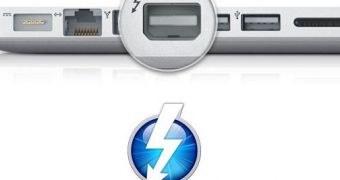Intel may have revealed the first iteration of its Light Peak architecture, codenamed Thunderbolt, but it seems that only two protocols are supported and that the others will need device makers to buy extra controllers.
Intel has, for quite a while, been talking about its Light Peak technology that is known to be much faster than USB 3.0.
Originally, the project relied on fiber optics in order to achieve extremely high transfer rates and scalability.
Then, the Santa Clara, California-based company decided to use copper wires in the first iteration of the standard, known as Thunderbolt 1.0.
Having now been launched as part of Apple's MacBook Pro, the web is swarming with news of it, even some that may or may not come across as worrisome or bothersome.
Light Peak was, initially, meant to support many different protocols, but Thunderbolt 1.0 only includes two, those being PCI Express and DisplayPort.
"PCI Express and DisplayPort are supported natively. Other protocols can be supported via adapters," said Dave Salvator, a spokesman for Intel, in an interview with X-bit labs.
Thunderbolt uses two independent channels and communicates in both directions in order to achieve a bandwidth of 10 Gbps over a single cable.
That said, there really aren't storage units that can utilize the throughput and HDDs won't be able to work with it unless their makers buy controller chips for compatibility with the I/O interface.
This means that storage devices will probably stick to USB 3.0, which is just fine with Intel, apparently. Thunderbolt is meant to stick to the professional market for now.
"We see Thunderbolt and USB 3.0 as complementary, we continue to support USB 3.0," Mr. Salvator said.
"The combination of the very fast data transfer and beyond-HD display support on a single slender cable has great appeal for HD media creators, especially who work on laptops. Those same features also solve the big challenges posed by the growing HD media libraries many of us now own.”

 14 DAY TRIAL //
14 DAY TRIAL //